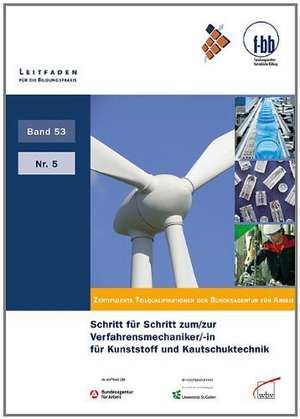Schritt für Schritt zum/zur Verfahrensmechaniker/-in für Kunststoff und Kautschuktechnik: Leitfaden für die Bildungspraxis, cartea 53-5
Autor Brigitte Geldermann, Matthias Kohl, Sylvia Krenn, Christine Küfner, Florian Neumann, Beate Zeller Editat de Herbert Loebe, Eckart Severingde Limba Germană Paperback – 10 ian 2012
Din seria Leitfaden für die Bildungspraxis
-
 Preț: 119.64 lei
Preț: 119.64 lei -
 Preț: 118.08 lei
Preț: 118.08 lei -
 Preț: 144.80 lei
Preț: 144.80 lei -
 Preț: 114.31 lei
Preț: 114.31 lei - 11%
 Preț: 585.15 lei
Preț: 585.15 lei -
 Preț: 110.74 lei
Preț: 110.74 lei -
 Preț: 126.66 lei
Preț: 126.66 lei - 5%
 Preț: 103.34 lei
Preț: 103.34 lei -
 Preț: 112.92 lei
Preț: 112.92 lei -
 Preț: 114.74 lei
Preț: 114.74 lei - 5%
 Preț: 108.87 lei
Preț: 108.87 lei -
 Preț: 123.56 lei
Preț: 123.56 lei -
 Preț: 124.55 lei
Preț: 124.55 lei -
 Preț: 113.83 lei
Preț: 113.83 lei -
 Preț: 124.41 lei
Preț: 124.41 lei -
 Preț: 127.72 lei
Preț: 127.72 lei -
 Preț: 121.81 lei
Preț: 121.81 lei -
 Preț: 121.95 lei
Preț: 121.95 lei -
 Preț: 126.03 lei
Preț: 126.03 lei -
 Preț: 111.30 lei
Preț: 111.30 lei -
 Preț: 123.99 lei
Preț: 123.99 lei -
 Preț: 141.18 lei
Preț: 141.18 lei -
 Preț: 138.20 lei
Preț: 138.20 lei -
 Preț: 141.74 lei
Preț: 141.74 lei -
 Preț: 144.93 lei
Preț: 144.93 lei -
 Preț: 149.21 lei
Preț: 149.21 lei
Preț: 127.79 lei
Nou
Puncte Express: 192
Preț estimativ în valută:
24.45€ • 25.23$ • 20.41£
24.45€ • 25.23$ • 20.41£
Carte indisponibilă temporar
Doresc să fiu notificat când acest titlu va fi disponibil:
Se trimite...
Preluare comenzi: 021 569.72.76
Specificații
ISBN-13: 9783763949427
ISBN-10: 3763949429
Pagini: 76
Dimensiuni: 4 x 297 x 10 mm
Greutate: 0.27 kg
Editura: wbv Media GmbH
Seria Leitfaden für die Bildungspraxis
ISBN-10: 3763949429
Pagini: 76
Dimensiuni: 4 x 297 x 10 mm
Greutate: 0.27 kg
Editura: wbv Media GmbH
Seria Leitfaden für die Bildungspraxis
Notă biografică
Beate Zeller ist Mitglied der wissenschaftlichen Leitung im Forschungsinstitut Betriebliche Bildung (f-bb). Florian Neumann, Matthias Kohl, Sylvia Krenn und Christine Küfner sind wissenschaftliche Mitarbeiter beim f-bb.
Cuprins
1 Einleitung2 Überblick über die Struktur der Teilqualifikationen2.1 Mindestvoraussetzungen zur Teilnahme an der Qualifizierung2.2 Modell und Struktur der Teilqualifikationen3 Beschreibung der Teilqualifikationen3.1 TQ 1 - Fertigungsvoraussetzungen für die Kunststoffverarbeitung schaffen3.2 TQ 2 - Bauelemente und einfache Baugruppen fertigen3.3 TQ 3 - Formteile durch Spritzgießen fertigen3.4 TQ 4 - Halbzeuge durch Extrudieren fertigen3.5 TQ 5 - Bauteile/Formteile durch Laminieren herstellen3.6 TQ 6 - Formteile durch Blasformen herstellen4 Weiterführende Informationen4.1 Weblinks4.2 Beispielhafte Lehrbücher
